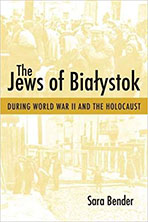The Jews of Białystok During World War II and the Holocaust

Sara Bender
Jewish society as an active protagonist in the story of the Holocaust
This history of Jewish Białystok during World War II provides an in-depth analysis of one of the largest Jewish communities to pass from Soviet to German occupation, and it enhances our understanding of the response of Polish Jewry to the Holocaust. The Białystok community’s fate is representative of many other Jewish communities in Poland and Lithuania, but unlike other communities, Białystok Jews left an unusually large documentary record. Exhaustive research in archival sources, including first-person testimonies and memoirs, enables Bender to create a multifaceted account of the motivations of Jewish communal leaders as well the attitudes and behavior of ordinary men and women as they grappled with an inhumane occupation and severe adversity.
Bender’s conclusion, in which she compares the history of the Białystok community and ghetto to several other major communities, including Warsaw and Vilna, makes the volume an even richer contribution to the study of Polish Jewry during the Holocaust.
Expand All
“Sara Bender’s book is an outstanding example of what a historian can do to illuminate the real, not the imagined, history of the Shoah. This thorough investigation of both German policies and, mainly, the Jewish reactions to the unexpected onslaught on Jewish lives, does away with preconceptions and historical errors. A most important addition to our knowledge.”—Prof. Yehuda Bauer, Academic Adviser of Yad Vashem
“The ghetto phenomenon was central to the experience of East European Jewry during the Holocaust. However, the picture of ghetto life often presented in comprehensive scholarly studies and educational material, alike, is actually based on materials from the two major ghettos, Lodz and Warsaw, established in 1940 in Nazi-occupied Poland, that is, before the Final Solution. But of the more than 1100 ghettos established by the Nazis and their allies, the great majority came into being after the invasion of the Soviet Union. Therefore, the ghettos of this period should get much more attention than hitherto given them. Dr. Bender's comprehensive study of the Jews of Białystok during WW II and the Holocaust sets an example in this regard: it tells a multifaceted story of a Polish Jewish community, first conquered and suppressed by the Soviets (1939–1941), then persecuted and murdered by the Nazis. Her study is thus an important contribution to the understanding of Jewish society as an active protagonist in the story of the Holocaust.”—Prof. Dan Michman, Professor of Modern Jewish History, Bar-Ilan University, and Chief Historian, Yad Vashem
“The Jews of Białystok During World War II and the Holocaust is an important work on one of the most understudied and fascinating of Poland’s Ghetto. Bender’s study is meticulous, her research wide ranging, her treatment of the sources authoritative. She never forces the evidence upon the readers, but sets it out with layers and layers of understanding.” —Michael Berenbaum, Professor of Jewish Studies, American Jewish University, Director, Sigi Ziering Institute: Exploring the Ethical and Religious Implications of the Holocaust, and Executive Editor, Encyclopaedia Judaica, Second Edition.
About the Author
Sara Bender is associate professor in the Department of Jewish History at Haifa University. She is the associate editor of Yad Vashem’s Encyclopedia of the Righteous Among the Nations (2007).
